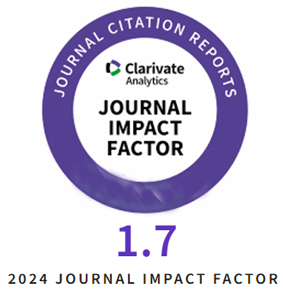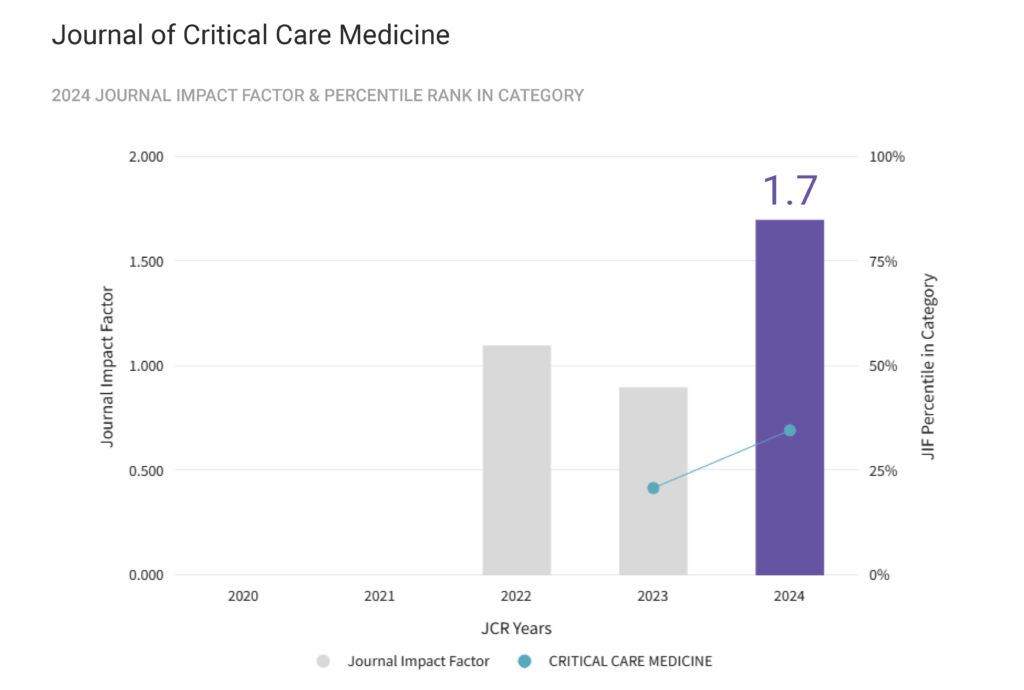Intra-cardiac thrombosis is one of the most devastating complications during liver transplantation. In the majority of cases, ICT, followed by massive pulmonary embolism, is commonly occurring shortly after liver graft reperfusion, but it has been reported to occur at any stage of the surgery. We present a series of 3 cases of intra-cardiac thrombosis during orthotopic liver transplantation surgery, including a case of four-chamber intra-cardiac clot formation during the pre-anhepatic stage. This article represents a single-centre 14 year-long experience. Intra-operative TEE is the gold standard to diagnose intra-cardiac thrombosis, monitoring its size, location and dynamics, as well as myocardial performance and the effects of resuscitation efforts.
Author Archives: administrare
Volume 6, Issue 3, July 2020
proba video link
A Comparison of Nosocomial Infection Density in Intensive Care Units on Relocating to a New Hospital
Background: The study aimed to investigate the changes in nosocomial infection density after patients were transferred to the intensive care unit (ICU) of a new-build hospital.
Methods: The types and rates of nosocomial infections were obtained for a one-year period retrospectively before leaving the old hospital premises and for a one-year periods after moving into the new hospital. The intensive care unit in the “old” premises was comprised of a 17-bedded hall, and thirty-three nurses shifted to work forty-eight hours a week, with each nurse assigned to provide care for two patients. The intensive care unit in the “new” premises consisted of single rooms, each with twenty-eight beds.
Results: The median nosocomial infection density decreased from 23 to 15 per 1000 in-patient days. The catheter-related urinary tract infection rate decreased from 7.5 to 2.6 per100 catheter days.
Conclusions: Treatment of patients in the new hospital resulted in a decrease in nosocomial infection density.
Mechanical Ventilation – A Friend in Need?
The development of modern medicine has imposed a new approach both in anaesthesiology and in intensive care. This is the reason why, in the last decades, more and more devices and life-support techniques were improved in order to achieve the highest medical outcomes.
Key features of the critically ill patient are severe respiratory, cardiovascular or neurological derangements, often in combination, reflected in abnormal physiological observations. All these changes converge towards the establishment of pulmonary or extrapulmonary respiratory failure requiring mechanical ventilatory support. In the current conception, mechanical ventilation does not represent a curative method for respiratory pathology, however, it represents a bridge therapy ensuring the rest and preservation of respiratory muscles, improves gas exchange and assists in maintaining a normal pH until the recovery of the patient [1].
Despite decades of research, there are limited therapeutic options directed towards the underlying pathological processes and supportive care with mechanical ventilation remaining the cornerstone of patient management. [More]
Opioid Use Is Associated with ICU Delirium in Mechanically Ventilated Children
Introduction: Pediatric delirium is a significant problem when encounterd in an intensive care unit (ICU). The pathophysiology of pediatric delirium is complex and the etiology is typically multifactorial. Even though various risk factors associated with pediatric delirium in a pediatric ICU have been identified, there is still a paucity of literature associated with the condition, especially in extremely critically ill children, sedated and mechanically ventilated. Aim of the study: To identify factors associated with delirium in mechanically ventilated children in an ICU.
Material and Methods: This is a single-center study conducted at a tertiary care pediatric ICU. Patients admitted to the pediatric ICU requiring sedation and mechanical ventilation for >48 hours were included. Cornell Assessment of Pediatric Delirium scale was used to screen patients with delirium. Baseline demographic and clinical factors as well as daily and cumulative doses of medications were compared between patients with and without delirium. Firth’s penalized maximum likelihood logistic regression was used on a priori set of variables to examine the association of potential factors with delirium. Two regression models were created to assess the effect of daily medication doses (Model 1) as well as cumulative medication doses (Model 2) of opioids and benzodiazepines.
Results: 95 patient visits met the inclusion criteria. 19 patients (20%) were diagnosed with delirium. Older patients (>12 years) had higher odds of developing delirium. Every 1mg/kg/day increase in daily doses of opioids was associated with an increased risk of delirium (OR=1.977, p=0.017). Likewise, 1 mg/kg increase in the cumulative opioid dose was associated with a higher odds of developing delirium (OR=1.035, p=0.022). Duration of mechanical ventilation was associated with the development of delirium in Model 1 (p=0.007).
Conclusions: Age, daily and cumulative opioid dosage and the duration of mechanical ventilation are associated with the development of delirium in mechanically ventilated children.
Neuroleptic Malignant Syndrome or Catatonia? A Case Report
Introduction: A review of the literature has shown that there are many similarities in the presentation of neuroleptic malignant syndrome (NMS) and catatonia. Attempts to reconcile the differences have been made by suggesting that NMS and catatonia may represent different presentations of the same illness or that they lie within the same spectrum of a poorly understood clinical syndrome. The described case is of a patient who presented with NMS and catatonia which was difficult to diagnose, but which responded to treatment with intravenous diazepam.
Case presentation: The case concerns a 22-year-old male admitted for pulmonary hypertension to an intensive care unit (ICU). Three days following admission, he developed a high fever that did not respond to antibiotics. The patient then developed rigidity, nocturnal agitation, decreased responsiveness, and somnolence. Without the use of bromocriptine (Novartis, Basel, Switzerland) or dantrolene (Par Pharmaceuticals, Chestnut Ridge, USA) discontinuation of neuroleptics combined with intravenous diazepam (Pfizer, NY, USA) led to a very rapid response and marked improvement in the case.
Conclusions: Early recognition and management of NMS and MC in a complex, gravely ill patient, may be accomplished in the ICU despite obfuscation of traditional signs and symptoms of the NMS and MC syndrome. Such interventions can have life-saving effects on patients in danger of fatal autonomic instability.
Monitoring Anticoagulation with Unfractionated Heparin on Renal Replacement Therapy. Which Is the Best aPTT Sampling Site?
Background: Controlled anticoagulation is key to maintaining continuous blood filtration therapies. Objective: The study aimed to compare different blood sampling sites for activated partial thromboplastin time (aPTT) to evaluate anticoagulation with unfractionated heparin (UFH) in continuous renal replacement therapy (CRRT) and identify the most appropriate sampling site for safe patient anticoagulation and increased filter life span.
Method: The study was a prospective observational single-centre investigation targeting intensive care unit (ICU) patients on CRRT using an anticoagulation protocol based on patient characteristics and a weight-based modified nomogram. Eighty-four patients were included in the study. Four sampling sites were assessed: heparin free central venous nondialysis catheter (CVC), an arterial line with heparinised flush (Artery), a circuit access line (Access), and a circuit return line (Postfilter). Blood was sampled from each of four different sites on every patient, four hours after the first heparin bolus. aPTT was determined using a rapid clot detector, point of care device.
Results: A high positive correlation was obtained for aPTT values between CVC and Access sampling sites (r (84) =0.72; p <0 .05) and a low positive correlation between CVC and Arterial sampling site (r (84) =0.46, p < 0.05). When correlated by artery age, the young Artery (1-3 day old) correlates with CVC, Access and Postfilter (r (45) = 0.74, p >0.05). The aPTT values were significantly higher at Postfilter and Arterial sampling site, older than three days, compared to the CVC sampling site (p<0.05).
Conclusion: Considering patient bleeding risks and filter life span, the optimal sampling sites for safe assessment of unfractionated heparin anticoagulation on CRRT during CVVHDF were the central venous catheter using heparin free lavage saline solution, a heparinised flushed arterial catheter not older than three days, and a circuit access line
Hypoxic Respiratory Failure Further Complicated During Airway Exchange Catheter Placement
Introduction: An airway exchange catheter is a hollow-lumen tube able to deliver oxygen and maintain access to a difficult endotracheal airway. This case report demonstrates an undocumented complication associated with an airway exchange catheter and jet ventilation, particularly in a patient with reduced airway diameter due to thick endotracheal secretions. Due to the frequent use of airway exchange catheters in the intensive care unit, this report highlights an adverse event of bilateral pneumothoraces that can be encountered by clinicians.
Case Presentation: This case report describes a 24-year-old female with severe adult respiratory distress syndrome and thick endotracheal secretions whose hospital course was complicated by bilateral pneumothoraces resulting from the use of an airway exchange catheter connected to jet ventilation. During the exchange, the catheter occluded the narrowed endotracheal tube to create a one-way valve that led to excessive lung inflation.
Conclusion: Airway exchange catheters used with jet ventilation in a patient with a narrowed endotracheal tube and reduced lung compliance have the potential risk of causing a pneumothorax. Clinicians should avoid temporary concomitant oxygenation via jet ventilation in patients with these findings and reserve the use of airway exchange catheters for difficult airways.
Takotsubo Syndrome: Is This a Common Occurrence in Elderly Females after Hip Fracture?
Background: The prevalence of Takotsubo syndrome in hip fracture is not known.
Methods: Hip fracture patients were evaluated in a multidisciplinary unit. Patients with ECG abnormalities and increased troponin I values at the time of hospital admission were included in the study Follow-up was clinical at 30 days and by telephonic interview at one year.
Results: Between October 1st 2011 to September 30th 2016, 51of 1506 patients had preoperative evidence of myocardial damage. Eight, all females, fulfilled the Mayo criteria for Takotsubo syndrome, six had no coronary lesions. Hip surgery was uneventful, and all eight were alive at thirty days, and seven of these were still alive after one year. Forty-three patients had myocardial infarction: mortality at thirty days and one year were 11% and 44% (p<0.0001, Student’s t-test;log-rank test).
Conclusion: At least 15% of patients with hip fracture and preoperative myocardial damage had Takotsubo syndrome. They were all elderly females. Contrary to myocardial infarction, Takotsubo syndrome has a favourable long term prognosis.










